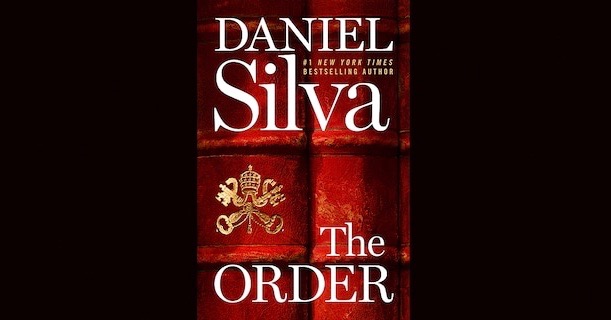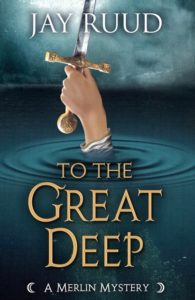The Order
Daniel Silva (2020)
[av_image src=’http://jayruud.com/wp-content/uploads/2014/08/Shakespeare-180×180.jpg’ attachment=’76’ attachment_size=’square’ align=’left’ animation=’left-to-right’ link=” target=” styling=” caption=’yes’ font_size=” appearance=’on-hover’]
Like several of Daniel Silva’s previous espionage thrillers featuring Israeli spy Gabriel Allon, his most recent novel (the 20th in the Allon series) premiered at No. 1 on the New York Times best-seller list this past August, so I feel a bit behind the times in not having read it until now. But in case you, like I, are late to the party, let me recommend the book to you. If you’ve read other books in this series, you will know pretty much what to expect when Silva is at the top of his game. If you haven’t read the previous 19 books, you can rest assured that you will not feel out of your depth if you start with this one—it’s fairly easy to fill in any backstory you may need as you read along.
As Ian Fleming’s and John Le Carré’s spy thrillers tended to reflect the realities of the Cold War during which they were written, Silva’s reflect current realities, particularly from the Israeli point of view, and so the villains tend to be Muslim extremists or Russian oligarchs bent on undermining Israeli security, though at times the fate of European Jewry during the Holocaust resurfaces, as it did, for example, in Silva’s fourth Allon novel, A Death in Vienna, in which a former Nazi officer is captured. In any case, the villains of Silva’s books tend to be one-dimensional, representing, as they do, forces opposed to Israel’s right to exist and, by extension, to Western democracy in general.
This latest novel, however, takes a different tack. You may well be reminded, as I was, of Dan Brown as you get into this novel, since it involves ancient Christian mysteries and a secret malevolent Catholic Order (hence the book’s title). Thus you may feel you’re reading something along the lines of The DaVinci Code, only written by a far superior writer.
The book begins with Allon being dragged to Venice by his wife Chiara and their two young children for a week-long family vacation. Gabriel, now halfway through his term as the director-general of Israeli intelligence, has not had any time off in the past year (and needs some down time to recover from wounds he received in a Paris bombing in book 19). Knowing that he has a great deal of difficulty sitting still, Chiara has even arranged for Gabriel to work for a while at his old occupation of art restoration on a fresco in a Venice church—a skill at which he is unsurpassed.
But like most things in Allon’s life, things don’t turn out as planned:
“It was nearly one a.m. by the time he crawled into bed. Chiara was reading a novel, oblivious to the television, which was muted. On the screen was a live shot of St. Peter’s Basilica. Gabriel raised the volume and learned that an old friend had died …”
That old friend is Pope Paul VII—who as Cardinal Pietro Lucchesi became Pope immediately after the death of John Paul II in Silva’s alternative universe. Gabriel, who once saved the Pontiff’s life, has become close to the Pope and to his loyal personal secretary, Archbishop Luigi Donati. The official word goes out that the Holy Father has died suddenly of a heart attack, but Donati contacts Gabriel and reveals his suspicions that Paul VII was murdered. He has two reasons to suspect this: First, the Swiss guard who was supposed to be protecting the Pope’s chambers that night has disappeared. And second, the Pope had been writing a letter to Gabriel himself that night he died—a letter that began “While researching in the Vatican Secret Archives, I came upon a most remarkable book …”
There are two mysteries, then, that need solving: Who killed the Pope, and what was this mysterious book that he wanted to put into Gabriel’s hands? As it turns out, the two quests are intertwined, as the second question turns out to be the “why” of the first question.
Readers of Silva’s previous novels are well acquainted with Paul VII and Donati, from The Confessor (series #3), The Messenger (series #6), and The Fallen Angel (series #12), and they know that this Pope, like real-life Pope Francis himself, is a reforming Pope who tends to make uncomfortable certain conservative and entrenched elements of the Catholic establishment. In previous installments, for example, Paul VII has made a point of officially apologizing for the Church’s involvement in past persecution of Jews, while Silva has been unrelenting in his condemnation of the Catholic Church, and particularly Pius XII, for their cooperation in the Holocaust. It is no surprise, therefore, that the group behind the Pontiff’s murder is a significant (fictional) society within the Church called the Order of Saint Helena, who plan to put their own puppet on the Papal throne, and who are allied with extreme right wing neo-fascist forces throughout Europe.
In this, of course, Silva is reflecting growing concerns over such movements in contemporary Europe, and he connects such xenophobic hatred of Muslim immigrants with anti-Semitism, seeing them as typically going together. His novel even has new right-wing leaders emerging in France, Germany, Austria and Italy, a nightmarish vision of the near-future. And he is not beyond flimsily-veiled references to current politics in America as well: In describing the new fascist leader of Italy, in what must have been last minute addition to the novel published in July, he creates an unmistakable caricature of a real-life head of state:
“Gabriel nodded slowly. ‘And how do you suppose an incompetent subliterate like [Prime Minister] Saviano will react under those circumstances? Will he listen to medical experts, or will he think he knows better? Will he tell his people the truth, or will he promise that a vaccine and lifesaving treatments are just around the corner?’
“ ‘He’ll blame the Chinese and the immigrants and emerge stronger than ever,’ Ferrari looked at Gabriel seriously. ‘Is there something you know that you’re not telling me?’
“ ‘Anyone with half a brain knows we’re long overdue for something on the scale of the Great Influenza of 1918. I’ve told my prime minister that of all the threats facing Israel, a pandemic is by far the worst.’ ”
As for the book the Pope had intended to share with Gabriel, this turns out to be a (fictional) Gospel of Pilate, in which the Roman procurator, late in his life, purportedly gave his own account of the crucifixion of Jesus. Much of Gabriel’s time in the novel is spent looking for this book, and much of Silva’s prose is spent explaining biblical scholarship concerned with the composition and canonization of the four recognized gospels. (It should be noted that evangelical Protestant reviewers of this book have objected to these arguments, though readers should be aware that all reputable, objective biblical scholars accept the broad outline of what Silva summarizes here.) Silva focuses particularly on what Gabriel calls the “vicious slander” of Matthew 27.25, when the crowd at Jesus’s condemnation cries out in one voice to Pilate “His blood be on us and on our children”—nine words that Gabriel (and Silva) contend are the cause of all subsequent pogroms, persecutions, and genocidal attacks by Christians on Jews. (Let me point out that this is almost certainly not true. Their inclusion in the gospel is a symptom of bad blood between the two related faiths that had already been brewing for a generation before Matthew’s gospel was written around 80 C.E. If in fact those words were the cause of Jewish persecution, they would have had an immediate effect, but in fact relations between the faiths in Europe in the first thousand years of Christianity were relatively peaceful for the most part. It was not until the religious fervor of the Crusades that anti-Jewish feeling erupted into widespread violence. Christians did not need those words in Matthew to lash out. They’d have done it anyway—those words were simply a convenient excuse).
At any rate, the Order wants to suppress this book, since they believe that in revising the Gospel story of the crucifixion, it would undermine the entire basis of the faith. (In this too Silva is mistaken. Descriptions of the crucifixion in the four Gospels differ enough that no one can take them as completely factual, since they already contradict one another. Discovering that the Romans and not the Jews were responsible for the crucifixion would certainly not change anything. Anybody who can read the canonical Gospels can already figure that out, Matthew’s insertion notwithstanding). But the novel doesn’t sink or swim with its assessment of the Gospels. The quest for Pilate’s Gospel is a great adventure, as is the tracking down of the lethal elements of the Order of Saint Helena, and the fast-paced story moves toward an improbable climax in the Sistine Chapel at the conclave of cardinals. Silva even adds an uncharacteristic suggestion of a supernatural element to the story.
Silva is quite simply the best writer of political thrillers active today, and this novel is as good as anything in his Gabriel Alon series. I recommend it highly. Four Shakespeares worth, in fact.
NOW AVAILABLE:
To the Great Deep, the sixth and final novel in my Merlin Mysteries series, is now available from the publisher, Encircle Publishing, at http://encirclepub.com/product/to-the-great-deep/
You can also order from Amazon (a Kindle edition is available) at https://www.amazon.com/Jay-Ruud/e/B001JS9L1Q?ref=sr_ntt_srch_lnk_1&qid=1594229242&sr=8-1
Here’s what the book is about:
When Sir Agravain leads a dozen knights to arrest Lancelot in the queen’s chamber, he kills them all in his own defense-all except the villainous Mordred, who pushes the king to make war on the escaped Lancelot, and to burn the queen for treason. On the morning of the queen’s execution, Lancelot leads an army of his supporters to scatter King Arthur’s knights and rescue Guinevere from the flames, leaving several of Arthur’s knights dead in their wake, including Sir Gawain’s favorite brother Gareth. Gawain, chief of what is left of the Round Table knights, insists that the king besiege Lancelot and Guinevere at the castle of Joyous Gard, goading Lancelot to come and fight him in single combat.
However, Merlin, examining the bodies on the battlefield, realizes that Gareth and three other knights were killed not by Lancelot’s mounted army but by someone on the ground who attacked them from behind during the melee. Once again it is up to Merlin and Gildas to find the real killer of Sir Gareth before Arthur’s reign is brought down completely by the warring knights, and by the machinations of Mordred, who has been left behind to rule in the king’s stead.


